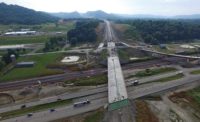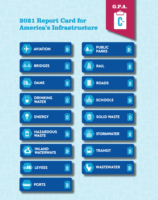Bridges and roads each received the poorest grades of “D-” from the Mississippi Section of the American Society of Civil Engineers (ASCE) in its the 2020 Report Card for Mississippi’s Infrastructure out of the 12 graded categories.
The report card, released April 14, gave Mississippi an overall grade of “D+” for its infrastructure systems.
Ports and rail both fared the best, with grades of “B-,” while dams, drinking water, inland waterways, levees and wastewater each received a “D,” and aviation, energy and solid waste each received a “C.”
“B” grades indicate that infrastructure in that category is “good, adequate for now,” and “C” grades indicate that infrastructure is “mediocre, requires attention.” A “D” grade indicates infrastructure that is “poor, at risk.”
“Our infrastructure has faced numerous unprecedented challenges such has hurricanes, tornadoes, droughts and floods – yet when Mississippians are faced with a challenge, we pull ourselves up by the bootstraps and we face that challenge,” said Jacob Forrester, chair of the report card, in a statement. “If we want to continue our long-standing tradition of hospitality and ensure good-paying jobs, we must focus on modernizing our roads, bridges, drinking water systems, airports and ports and more.”
According to the report, out of Mississippi’s 17,072 bridges, more than 400 timber pile bridges have been closed to the public since 2018 due to the Federal Highway Administration deeming structures unsafe and being insufficiently inspected. In 2018, 1,603 of the 1,702 bridges, or 9.4%, were deemed structurally deficient, which is more than the 7.6% of bridges nationwide that were identified as structurally deficient the same year, the report states.
Meanwhile, nearly 40% of major urban road miles in the state are in poor condition, which is double the national rate, the report uncovers.
Nearly half of the state’s more than 900 miles of concrete and earthen levees that protect approximately four million people and $21.8 billion in property are rated unacceptable. In addition, aging drinking water systems are losing as much as 30% to 50% of their treated water to leaks and breaks, the report indicates, further noting that these problems are mostly due to the age of these systems, some of which date as far back to the 1920s.
Among the recommendations to fix these issues were establishing a grant program for 21st century technical career training in the drinking water and wastewater sectors; designing, operating, maintaining and expanding infrastructure using consensus-based codes, specifications and standards that reduce the potential loss of jobs, economic opportunity and critical natural resources; and developing and disseminating a comprehensive education campaign on the true costs and savings associated with investment in critical infrastructure around the state.




Post a comment to this article
Report Abusive Comment